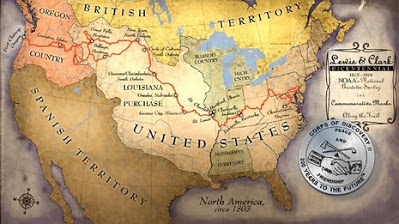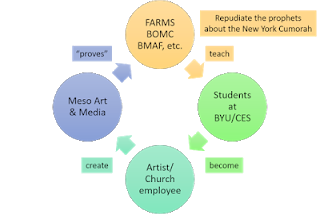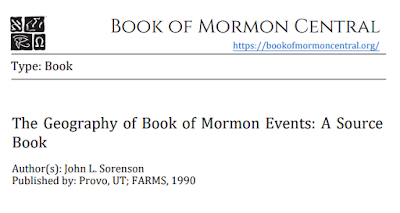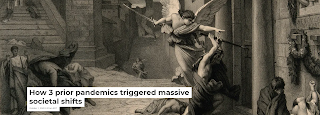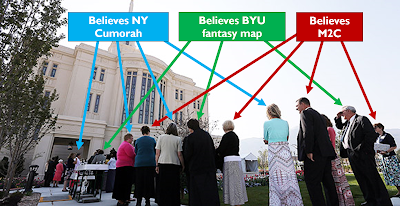Source Book framing of the issues
We’ve been discussing Brother Sorenson’s Source Book. Today we’ll look at how it frames the issues. Brother Sorenson did a great job articulating a useful approach to the issues, but then he stumbled by making M2C-driven assumptions within a few pages of pointing out how such assumptions should not be made!
Bottom line: The M2C citation cartel defies Brother Sorenson’s reasonable framework because they do not want Church members to make informed decisions.
_____
page 210.
If we are to progress in this task, we must chop away and burn the conceptual underbrush that has afflicted the effort in the past.
Among the conceptual underbrush is the assumption that Joseph and Oliver were ignorant speculators who misled the Church with a false narrative about the New York Cumorah. But what does Brother Sorenson write in the very next sentence?
We must stop asking, as so many do, what have the Brethren said about this in the past? It is clear enough (see Appendix A) that none of them knew the answer (which is what some of them have said often enough).
While Brother Sorenson included Letter VII in Appendix A, look at how he edited it:
p. 372.
Oliver Cowdery. Latter Day Saints’ Messenger and Advocate, July 1835, p. 158-159. (Reprinted in The Times and Seasons 2,1841, page 379, and again in The Improvement Era 2,1899, pages 729-734.)
Re. the New York hill Cumorah: “At about one mile west rises another ridge of less height, running parallel with the former .. . between these hills, the entire power and national strength of both the Jaredites and Nephites were destroyed.
Here is the unedited passage:
At about one mile west rises another ridge of less height, running parallel with the former, leaving a beautiful vale between. The soil is of the first quality for the country, and under a state of cultivation, which gives a prospect at once imposing, when one reflects on the fact, that here, between these hills, the entire power and national strength of both the Jaredites and Nephites were destroyed.
By omitting Oliver’s statement that the New York Cumorah was a fact, Brother Sorenson accommodated his theory that this was merely Oliver’s (incorrect) opinion.
Today, most M2C followers I’ve discussed this with have never heard of Letter VII, but even those who have heard of it say it was merely Oliver’s opinion. To the extent they’re relying on the Source Book, you can see why they think that.
Brother Sorenson didn’t mention that Letter VII was also copied into Joseph’s history, although he might not have known that. You can see it now in the Joseph Smith Papers, here:
https://www.josephsmithpapers.org/paper-summary/history-1834-1836/90
He also didn’t mention that Letter VII was republished in the Millennial Star, the Gospel Reflector (with the express consent of Joseph Smith), and the Prophet (by Joseph’s brother William), but maybe he didn’t know all of that, either. Other than the scriptures themselves, these essays on Church history that Oliver wrote with Joseph’s assistance were the most republished articles in the Church during Joseph’s lifetime. Everyone knew about them, including the fact of the New York Cumorah.
There is nothing in Appendix A that suggests, let alone supports, Brother Sorenson’s claim that “it is clear enough that none of them knew the answer” about the New York Cumorah. Like all M2C believers do, Brother Sorenson conflates the issue of Cumorah with the rest of the geography issues.
This is a favorite tactic of my critics, too. I’ve always said that while I don’t think Mesoamerica makes sense for several reasons, I don’t categorically reject it or any other geography, so long as the proposed geography retains the New York Cumorah of Mormon 6:6. That’s the only definite pin in the map the prophets have provided, and everything beyond that is open for discussion.
_____
Continuing at page 210:
Where we must begin is with the words of Mormon and his associates who kept the original records.
On page 216, Brother Sorenson writes, “6. I assume too that all the relations and phenomena known in present day nature prevailed in Book of Mormon times. That is, water ran from mountains to seas, the “headwaters” of the river Sidon had to be higher in elevation than any point downstream, and the river ultimately debouched into a sea….
“Headwaters” is not a term in the text. It is not one of the “words of Mormon and his associates.”
This is an example of what I call the Sorenson translation. I once had a conversation with a well-known M2C author who referred to the “headwaters” and I said, “That’s not a term in the text.” He replied, “Of course it is.” I asked him to show me. He actually looked! Of course he couldn’t find it. After a while, he found “head of Sidon,” which, as I pointed out, is a different term that has more than one meaning. There are other examples of the Sorenson translation throughout the Source Book.
Look at the very next sentence:
From their words we must derive every scrap of meaning; I assume that their knowledge of geography was so integral and holistic that meanings are tucked into their records at a level below intention.
This is Brother Sorenson’s rationale for developing his own translation of the text, which every M2C believer has accepted. They are looking through the text at the hidden meanings that only they, the M2C scholars, can discern. It’s fascinating from an psychological perspective to see this degree of lack of self-awareness.
We must sift for these. We cannot omit any of them, for crucial clues may occur in or between words or lines where we had not seen them before.
This is good analysis, but not always adhered to. Worse, the hidden meanings come to take precedence over the text itself.
To summarize, the following steps are necessary, and no other set of steps nor any other order for accomplishing them can solve our problem:
1. Purge our minds as far as possible of preconceptions about where the Book of Mormon lands were.
One well-known BYU scholar has said he “cannot unsee” Mesoamerica when he reads the Book of Mormon. Most, if not all, members of the Church educated by CES or BYU (or Book of Mormon Central) would have to say the same thing because the M2C interpretation has been deliberately imposed on Church members from a young age.
As most members of the Church to draw a Book of Mormon scene and they’ll start with a Mayan pyramid.
Nearly every time when I show or discuss the Moroni’s America framework, people respond by saying “I’ve never seen that before, but it makes sense.”
In any rational scenario, Church members would be fully educated about alternatives. They would know what the prophets have taught about Cumorah. They would understand why the scholars repudiate those teachings. They would be able to roughly sketch both Mesoamerican and North American settings.
But the M2C citation cartel doesn’t want Church members to make informed decisions.
The M2C citation cartel continues to deliberately censor alternatives to M2C. They openly defy Brother Sorenson’s step number 1 in solving the problem of Book of Mormon geography.
The worst of the bunch is Book of Mormon Central, which is spending millions of dollars to enforce M2C and censor alternatives. Their business model only works so long as Church members are kept in ignorance.
2. Analyze as freshly and completely as possible every geographical fact and sound inference which the texts require or make likely.
Once the LDS scholars decided the prophets were wrong, and the RLDS scholars were correct, on the issue of Cumorah, the LDs scholars abandoned any thought of analyzing anything freshly and completely. It has been pure bias confirmation ever since.
3. Realizing that in fact we cannot completely rid ourselves of preconceptions or make inferences without some factual or logical errors, we should guard against hidden biases or errors by displaying for examination by other students as much of our mental processing as we are able.
The M2C citation cartel has abandoned this step as well.
This requires writing out our work in detail; only written communication permits the careful examination by others that such work demands. (The resulting volume of writing may seem tedious to those not sufficiently motivated to the task.)
4. Mutual criticism (again ideally in writing) is essential to reveal points where different students can agree or where they need to improve their thinking or information. This criticism need not be uncharitable, although truth must be the ultimate standard.
The M2C citation has hired fine young scholars to fill the internet with uncharitable, ad hominem attacks against anyone who dares question M2C. They have repudiated Brother Sorenson’s reasonable framework just as completely as they have repudiated the teachings of the prophets.
5. By this repetitive process all should move toward consensus. However, the end result may be a conclusion that the text does not provide enough information, as read at this time, to come to full consensus on a single-text based model. That can only be learned by trying.
The M2C citation cartel has definitely moved toward consensus; that’s their justification for ongoing censorship of alternatives. A far better approach is the nominal neutrality articulated by the Gospel Topics Entry on Book of Mormon Geography, which unfortunately is not observed in practice.
6. So far as a single model emerges from this effort, then one-half—the prerequisite half—of the equation has been prepared. Only after this has happened can a definitive search for external correlations be carried out. Until then anything said about external geography, archaeology, linguistics or the like for any location in America can only be prejudicial to the suspension of opinion that we ought to maintain.
The M2C citation has managed to enforce the M2C interpretation of the text that, predictably, produces an M2C “model” reflected by the BYU and CES fantasy maps. The problem, of course, is that the M2C interpretation doesn’t really fit the real world; hence the fantasy maps.
Certainly there are numerous “real-world” maps based on the M2C citation, such as the one on the BYU Studies web page (which guides the editors so they properly comply with M2C in BYU Studies, just as they did in the Saints book).
But the goal of generating an “internal map” relies on a cascading series of assumptions. It’s easy to see why. Imagine someone generating an “internal map” of the Bible with no reference to the real world. No two people could possibly develop similar maps using the scanty geographical information in the text.
That’s why the only rational basis for constructing a map of the Book of Mormon is to start with the one known pin in the map, as declared by the prophets: the New York Cumorah.
Now that the M2C scholars have persuaded everyone to repudiate the teachings of the prophets, though, we end up with the BYU and CES fantasy maps, based on the M2C interpretation, which both implicitly and explicitly teaches students to think of the Book of Mormon in a fictional framework.
_____
The end.
Source: About Central America
